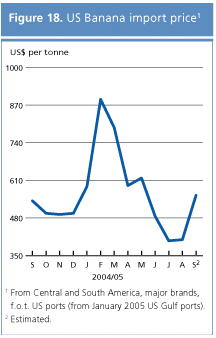Other relevant agricultural commodities
BANANA
|
 |
Import prices for bananas in the United States declined at the beginning of the summer as they traditionally do due to the competition of locally-produced fruit and reduced demand. However, they picked up in September and rose above the level of September 2004. In the EU import prices remained high during the summer 2005 in the wake of a shortage of import licenses. The negotiations on the rebinding of the EU tariff-quota system resumed after the WTO arbitration panel ruled in August that the EU’s envisaged tariff of 230 euro per tonne for banana imports from most favoured nations (MFN) would not result in at least maintaining their market access. The European Commission is now proposing a tariff of 187 euro per tonne which Latin American countries consider too high. As negotiations failed, on 26 September 2005, the EC requested a second WTO arbitration to determine whether its new proposal complies with the terms of the Doha Waiver. The same arbitrators have 30 days to give their ruling. Should they rule that the EC’s new proposal does not at least maintain total market access for MFN suppliers, the Doha waiver will cease to apply to bananas upon entry into force of the new EC tariff regime.

COFFEE
|
 |
Coffee prices averaged 92.3 US cents per pound for the first 8 months of 2005, which was 55.5 percent higher than the corresponding period in 2004, as strong market fundamentals continued to support prices. Industry sources reported a forecasted decline in world coffee production for the 2005/06 crop year along with a growing demand, and a predicted decline in stocks in exporting countries. Prices are expected to remain above last year’s average for the rest of the year, reflecting a lower output in Brazil, as coffee trees will yield less after providing an abundant crop in 2004/05, and a lower production in Viet Nam as a result of a severe drought. Coffee production in India is also expected to decline for the current 2004/05 season due to substantial damage brought by the white stem borer pest. Recent weakness in coffee prices for both July and August 2005 was mostly attributed to the seasonal slow down in roasting activities during the summer and an upward revision of the Brazilian coffee output for the 2005/06 season, which now stands at 1.9 million tonnes. Promotional activities in major producing and consuming countries have started to bear fruits with global consumption growth in 2004 estimated at about 3 percent. As it stands, production will need to keep up with rising demand, a situation that contrasts with the oversupplied market of the past four years.
COCOA
|
 |
The International cocoa price stood at 67.22 US cents per pound in August, considerably lower than the 22-month high of 79.72 US cents per pound reached earlier in the year in March. Lower prices reflected concerns over a reported global production surplus for the 2005/06, along with indications of stagnant cocoa consumption in the United States and Western Europe. Industry sources reported an estimated global surplus for the 2005/06 season of 70 000 tonnes, which compared with a deficit of about 100 000 tonnes in 2004/05. World cocoa consumption, measured by grindings of cocoa beans, showed only moderate growth in the current season, a result of reduced demand from confectionary manufacturers who have reportedly a build-up in stocks of cocoa powder and cocoa butter. Given no major changes in the fundamentals, the outlook for the cocoa prices will remain largely influenced by speculative buying and political developments in Côte d’Ivoire, which produces about 40 percent of the world output.

TEA
|
 |
FAO Tea Composite Price averaged $US 1.63 per Kg in July 2005, down 0.61 percent over the same period in 2004, reflecting losses in major tea auction markets. Calcutta auction prices were quoted 5.7 percent lower, while Mombassa prices averaged a 5.2 percent decline. Rising prices in Colombo, however, were not sufficient to give support to the FAO Tea Composite Price. Generally weaker international tea prices reflected rising production in major producing countries as well as a contraction in global export demand. India reported a 41.1 percent increase in production for the first 7 months of 2005, while higher output was also reported in Sri Lanka and Indonesia. These large harvests more than offset a recorded 3 percent decline in tea output in Kenya. In view of a continuing imbalance between supply and demand, the FAO Tea Composite Price is likely to remain under downward pressure for the remainder of 2005 and probably beyond. In reaction to the prevailing low international tea prices, the Inter Governmental Group (IGG) on Tea has reaffirmed, at its recent meeting in Bali, Indonesia, the need to produce better quality tea and eliminate the substandard varieties from the world market which would subsequently lead to higher prices. The Group agreed to appoint a working committee to work out an action plan based on ISO 3720 as the minimum standard to control excess supply.
|
